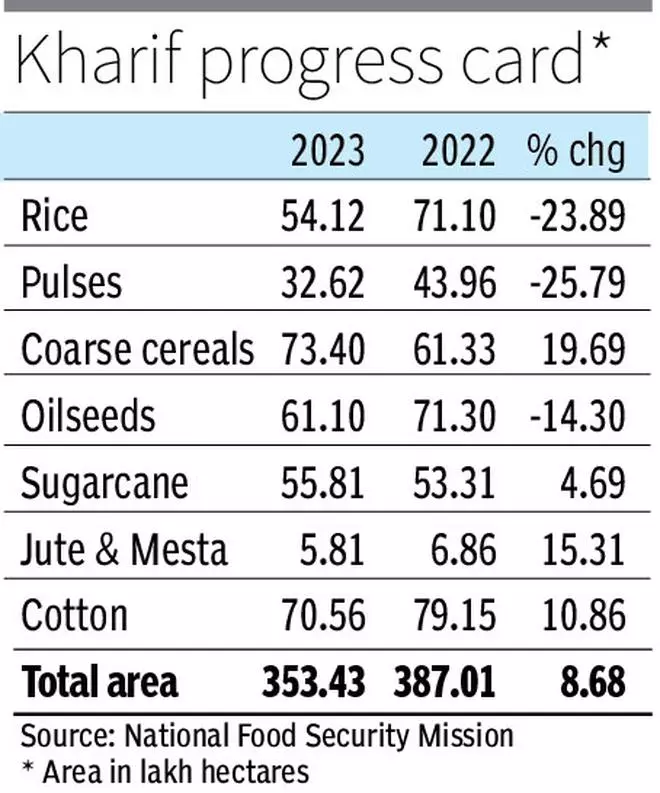Kharif sowing of most crops, barring sugarcane and coarse cereals, continues to trail but agriculture sector experts say there is no cause for worry.
According to data from the National Food Security Mission (NFSM), the overall coverage as of July 7 dropped by 8.68 per cent to 353.43 lakh hectares (lh) compared with 387.01 lh in the same period a year ago. “Sowing is lower than last year since the south-west monsoon was late this year. Farmers postponed sowing awaiting good showers. But now with monsoon catching up, sowing has begun to progress well,” said BK Singh, Director at BKC Aggregator Pvt Ltd & BKC Weathersys.
El Nino worries
“Last year, sowing began early. Usually, people look at the average and it does not reflect the true ground reality. Data in August will reflect the correct picture. Moreover, the Indian Meteorological Department (IMD) has forecast above normal rainfall in July. This should help cover the deficient areas and improve sowing,” said S Chandrasekaran, a trade analyst.
“There is good improvement in sowing. So far, it has been good. However, we are worried over El Nino,” said Singh. El Nino, which leads to drought and deficient rainfall in the Asian region, will likely set in this month, the IMD has said. “There is room for further improvement in sowing. Cotton sowing begins in Andhra Pradesh and Telangana in June. Both the States were rain deficient. It might pick up now,” Chandrasekaran said.
Monsoon deficiency shrinks
According to IMD, the deficiency in rainfall has shrunk to 3 per cent, though the southern peninsula has received 24 per cent lower than normal rainfall. Eastern and north-eastern parts have received 16 per cent deficient rainfall as of July 7.
On the other hand, central and north-western India — key kharif crops regions — have received normal and 39 per cent excess rainfall, respectively. “There is no need for worry over central and north-western parts as they have canals to help farmers irrigate their crops,” Chandrasekaran said.
Storage level
According to data from the Central Water Commission, the storage in 146 important reservoirs in different parts of the country as of July 6 was 51.064 billion cubic meters (BCM), which is 4 per cent lower than the level a year ago. However, it is 10 percentage points higher than the last 10 year’s average.
But the level in key rice-growing States such as Jharkhand (-16%), Odisha (-10%), West Bengal (-46%), Bihar (-42%), Uttarakhand (-18%), Uttar Pradesh (-20%) and Karnataka (-32%) has resulted in the sowing of the cereal during kharif lagging this year.
NFSM data showed the area under rice trailing nearly 24 per cent at 54.12 lh versus 71.10 lh a year ago. Last year, too, deficient rainfall in these areas, barring Karnataka, affected rice production, though the shortfall was more than made up during rabi cultivation.

Arhar down by 60%
Pulses coverage was over 25 per cent lower at 32.62 lh with the area under arhar (pigeon pea) down by 60 per cent and urad (black matpe) lower by over 30 per cent.
Among coarse cereals, bajra and jowar seem to be making up for losses in other crops. Their acreage has increased by 60 per cent and 44 per cent respectively, while the area under maize trails by 12 per cent. Coverage of small millets is also down by 44 per cent.
The area under oilseeds is down by 14.3 per cent with the coverage of soyabean lagging by 26.19 per cent at 35.63 lh, while sunflower acreage is down 73 per cent at 0.31 lh. Sowing in other important crops such as groundnut and sesame is up 12.9 per cent and 35 per cent, respectively.
Sugarcane planting has caught up with its area rising by 4.69 per cent to 55.81 lh, while cotton acreage is lower by over 10 per cent at 70.56 lh. Jute and mesta coverage has been reported 15.31 per cent lower at 5.81 lh.
A cyclonic circulation over West Bengal and North Odisha, which is currently lying over Jharkhand, should help farmers to plant more in the coming weeks. The IMD had predicted rain-deficient eastern and north-eastern regions heavy rainfall over the next three days.







Comments
Comments have to be in English, and in full sentences. They cannot be abusive or personal. Please abide by our community guidelines for posting your comments.
We have migrated to a new commenting platform. If you are already a registered user of TheHindu Businessline and logged in, you may continue to engage with our articles. If you do not have an account please register and login to post comments. Users can access their older comments by logging into their accounts on Vuukle.